by Mike Plambeck

You eagerly await the day that someone presses those metal house keys that signify home ownership into your hand, but it seems like a distant reality if you have bad credit. A lower than average credit score can seriously hinder your ability to purchase a home in the near future, particularly for a first time buyer.
However, many individuals and families become frustrated with the wait and don’t realize that there are still options available for first time home buyers with bad credit.
As long as you are willing to take action, a first time home buyer with bad credit can still purchase a home. It may require other compensating factors that will make you more attractive to a prospective lender, but the possibility is definitely still there.
Don’t lose heart when it comes to the dream of homeownership.
All you need to do is know what options are available to you. We can help you find bad credit home loan options by state and by city!
We Help You Qualify For A Low Credit Loan Fast
Fill Out The Form Below To Get Help Today!
What Should I Do First?
If you have poor credit, you need to know what steps you should take first to improve your status. Don’t become frustrated and stuck in your current predicament. You can be proactive by following some of these key steps to secure financing for your next home.
Talk to Your Lender About Credit Issues
The best thing you can do is be honest with your lender about your credit problems. While they can see the blemishes on your credit report, that doesn’t mean that they understand how those issues arose. Some families have extenuating circumstances that contributed to their low credit score.
For example, you might have maxed out a credit card during a major illness that left you or your spouse out of work for a while.
Lenders can sometimes make exceptions for these circumstances using manual underwriting. This will ultimately depend on the cause of your low credit score. If they aren’t able to make an exception based on the circumstances alone, your lender may be able to offer advice on what you can do next.
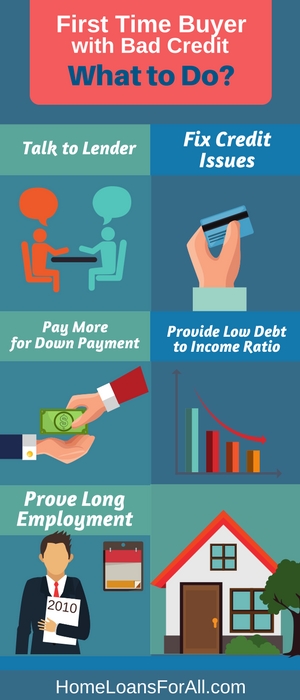
They can let you know which compensating factors could work in your favor, as well as steps you can take to correct your credit.
Fix Credit Issues If Possible
Sometimes, you might be able to correct your credit issues with little to no assistance from others. If you have blemishes on your credit report that need to be removed or resolved, this is a great time to start taking care of them. Removing miscommunications or old issues could give you a quick boost to your overall credit score.
Resolving your entire credit issue will require a little bit more time. The best ways to get a higher credit score are to start paying bills on time and to lower your overall credit utilization. You might not see a major difference in your credit score within the first few months, but it will slowly start to make an impact on your score.
Pay More for a Down Payment
When lenders issue financing for a new home, they are taking a risk that you might not be able to repay that loan. They can minimize their risk by making sure that borrowers have an excellent credit score and long employment history. However, they can also minimize their financial risk by requiring a higher down payment.
Having more money as a down payment allows lenders to have a little more peace of mind because it does build up your equity quickly.
A higher down payment gives lenders an opportunity to see that you can save responsibly, which might make them more apt to give you a loan in the first place. Keep in mind that this may extend your timeline to purchase a home due to the time it takes to scrape together a larger savings account.
During this time, you can also work on actively improving your credit score so you can receive more favorable terms when you do finally secure financing.
Provide a Low Debt to Income Ratio
Your debt to income ratio plays a major role in determining your eligibility for a loan. Most lenders prefer your debt to income ratio to equal 43 percent or less. This means that your total debts, including the new mortgage and interest payments, should be equal to or less than your gross monthly income.
When this ratio is lower, it gives you more expendable income for emergencies, savings, or potentially even making your mortgage payments on time.
A low debt to income ratio can give lenders a little more security about issuing financing to you upfront. Consider paying down some of your other auto loans, student loan debts, or credit card bills in order to achieve a lower ratio.
Prove Long Employment History
A steady source of employment can go a long toward making your lender feel more comfortable issuing financing for your next property. A long employment history means that you can obtain and keep a source of income, both of which make you more likely to fulfill your monthly mortgage obligation.
When you jump from job to job without a stable source of income, your employment history sends up red flags to lenders.
Try to prove a long employment history of at least two years in the same field or with the same company. Prepare to show your lender tax documents, pay stubs, and other documents that can verify your dates of employment.
First Time Home Buyers with Bad Credit: What Mortgage Options Are Available?
In addition to following some of the key steps for obtaining a mortgage, you should also know which programs you can utilize to obtain your financing. The federal government and private lenders often work together to make homeownership a reality for less-than-ideal candidates, particularly first time home buyers with bad credit.
Familiarize yourself with some of these programs before you head to your local bank.
FHA Loans
FHA loans are backed in part by the Federal Housing Administration. This extra security for the private lenders that work with FHA loans allows them to offer some advantageous features for first time home buyers with low credit scores. In particular, this program is known for lower interest rates and a low down payment.
Applicants who have a credit score of 580 or higher can qualify for a down payment as low as 3.5 percent. This represents a substantial savings over the twenty percent that is usually required for conventional mortgages. You might still qualify for an FHA loan if you have a lower credit score between 500 and 579.
The lender will require a ten percent down payment as a compensating factor for this greater risk.
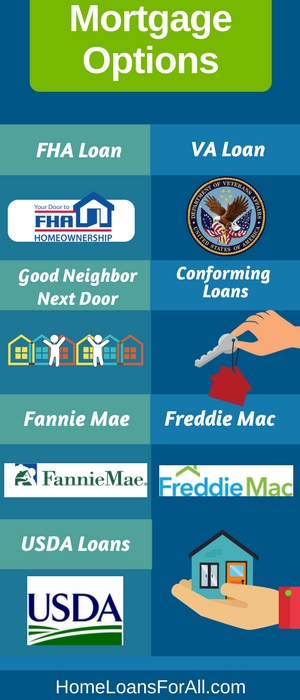
VA Loans
Are you looking for a mortgage designed specifically for a first time home buyer with bad credit and no down payment? This scenario isn’t often found in today’s housing market, but VA loans could be the answer to your problem. VA loans have no minimum credit score required, and they are well-known for their no down payment options.
Much like the FHA mortgages, the VA loans are partially backed by the Department of Veterans Affairs. You must be a veteran or an active duty service member in order to qualify for this program.
Applicants must meet stringent guidelines regarding their service commitments in order to qualify for their prerequisite Certificate of Eligibility.
Good Neighbor Next Door
One of the best options for first time home buyer programs with bad credit is the Good Neighbor Next Door sponsored by HUD. The homes available through this program are all foreclosures that previously had an FHA loan. As a result, they are now sold for extremely low rates that are only improved by this program.
The Good Neighbor Next Door program allows you to purchase one of these eligible properties from the HUD Homestore at half price.
The catch for a first time buyer with bad credit is that you must fall into one of the professions that qualify. This includes law enforcement officers, teachers, emergency medical technicians, and firefighters. You must also select a home that is located in the service district where you work.
This is a great choice for first time buyers who want to learn how to buy a house with bad credit. The steep discount offered on these properties makes it possible to lower your debt to income ratio and generate a down payment that represents a greater percentage of the home’s value.
These can sometimes be combined with the FHA loan for financing that gives you the maximum benefits.
Conforming Loans
A conforming loan is similar to a conventional mortgage that is for a property under $453,100. These loans comply with the standards set out by Fannie Mae and Freddie Mac, the government agencies that often help private lenders to fund mortgages. The benefits of these loans are that they typically have lower interest rates and lower down payments compared to their non-conforming counterparts.
You might face more stringent criteria with these conforming loans compared to FHA loans and VA loans. However, they could be a great option if you can’t find a property that qualifies for either of the other two mortgages. You are likely to have a higher down payment with conforming loans than you will on the other two programs.
Fannie Mae HomeReady Program
A first time home buyer with bad credit who is open to purchasing a foreclosed property may want to look into the Fannie Mae HomeReady program. This is an extremely beneficial program that allows you to purchase homes at a reduced rate while still securing financing through the FHA mortgage program. By purchasing a less expensive home, you can lower your projected debt to income ratio and shrink the size of your required down payment.
There may be some maximum income limits to purchase one of these HomeReady properties, so you will need to check on the specific details for your area. This could limit your options when it comes to purchasing a foreclosed home through this program. Keep in mind that a foreclosed home may need some repairs made before it is considered move-in ready.
This could be a great opportunity to purchase a fixer-upper.
Freddie Mac’s Home Possible Program
Do you want to purchase a home with a low down payment in a high-cost area or in an underserved community? Freddie Mac’s Home Possible program offers low- to moderate-income families an opportunity to do just that. The down payments required for this program range from three to five percent with flexibility on where the money comes from.
Your down payment could be a gift, a loan from family members, or from some type of secondary financing.
There are no credit scores necessary to obtain one of these mortgages. This is great for a first time home buyer who has no credit at all. If you do have a credit score, many borrowers want to see it come in around the mid-600 mark as a standard benchmark for manual underwriting on a Home Possible property.
USDA Loans
If you want to purchase a home in a rural area, the USDA home loan program could be for you. The United States Department of Agriculture backs these loans in order to make them more accessible to prospective home buyers. You might even be able to purchase one of these properties with a very low down payment if your lender requires a down payment at all.
Keep in mind that these might not be available to you until you do some work on your credit score. An automated approval typically requires a benchmark credit score of 640, but lower credit scores might be accepted with manual underwriting.
This grants you a far more subjective approval because an individual will actually be reviewing your entire application. You may want to explore this option if you had extenuating circumstances that led to your poor credit.
What Assistance Programs Are Available?
You can always make use of one of several assistance programs designed to help first time home buyers with bad credit. They might be able to make homeownership more accessible to you or offer advice on the next steps you need to take to make your dream into a reality.
Operation HOPE
Operation HOPE works with low-income families in underserved areas to make homeownership a more realistic goal. While they do offer some counseling and education on financial health, one of the primary benefits of the organization is their down payment assistance programs. They have a team of real estate professionals to help you find a home and counselors who can help you to find the right loan for your needs.
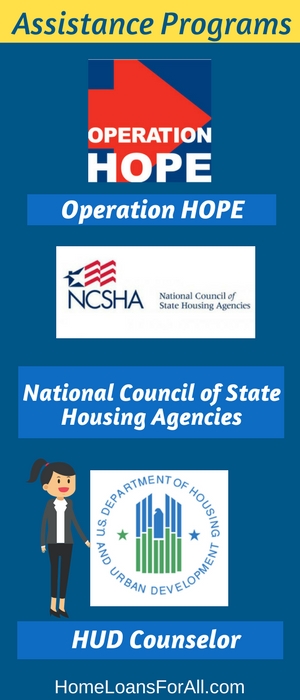
National Council of State Housing Agencies
The National Council of State Housing Agencies coordinates each state’s Housing Finance Agency (HFAs). These organizations are designed to help create affordable housing for the residents of their states through housing and community development programs.
They host conferences and provide educational resources to these HFAs through their National Conference of State Housing Boards to help them better inform potential homeowners of opportunities available to them.
Use a HUD Counselor
You can always receive free or low-cost financial counseling through a registered HUD counseling agency. The Department of Housing and Urban Development has compiled a list of professionals who can help you to find the resources you need in your local area.
They might be able to refer you to down payment assistance organizations or offer advice on how to improve your credit score and your chances of homeownership. If you’re facing foreclosure on your current home, this is also an excellent resource to help you stay in your home for longer.
What Can You Expect When You Have a Low Credit Score?
Individuals with a lower credit score should expect a few major differences from conventional mortgage programs. Perhaps the biggest difference from their peers that have better credit is the higher interest rates. Your lender is going to capitalize on the risk they take with your mortgage through higher interest rates.
These percentage points may not seem significant at the moment, but interest rates can cost you thousands of dollars over the course of your loan.
You will also typically be expected to contribute a higher down payment on your next purchase. A first time home buyer with bad credit might need to place a substantially higher down payment on their house than others who have had mortgages previously or who have a more polished credit score.
Much like the interest rate, a lender can use your down payment to give themselves a greater degree of security when it comes to issuing your loan.
Speak with a lender about how First Time Home Buyer Programs can work for you by clicking here!
Frequently Asked Questions
I’ve declared bankruptcy in the past. Do I qualify for any first time buyer programs?
Yes, you may still qualify for first time buyer programs once you meet the minimum waiting period following your bankruptcy. The waiting period will vary based on the specific financing program you select, but it could be over in as few as two years.
How do I buy a house with bad credit and no money down?
You will have to find a financing option that does not require a down payment, such as the VA loan program or the USDA mortgage option. There may be additional requirements you need to meet in order to qualify for these programs.
Conclusion
While first time home buyers with bad credit can find financing options, it is always better to wait until your credit scores improve. A higher credit score can save you thousands of dollars on the initial cost of homeownership, as well as on interest rates over the duration of your loan. Individuals with better credit scores tend to have lower interest rates and down payments compared to other borrowers.
If at all possible, try to move your credit score into the average range before you apply for a new mortgage. Waiting a few months or years could pay huge dividends for you in the long run.
by Mike Plambeck
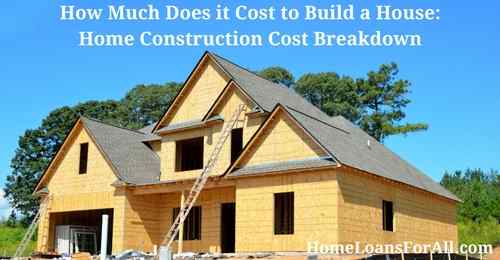
How much does it cost to build a house?
What all expenses will I run into when doing a new construction build?
These are common questions revolving in minds of people wondering how much does it cost to build a house.
A detailed discussion on the subject is given below.
How Much Does it Cost To Build A House
Average cost, though a reasonable estimate, may not resemble your actual cost. Its reason is that specifics of your project may fluctuate and your actual costs may be much lower or higher than the average.
Building or Buying a Home? Click Here To Pre Qualify for Financing Fast.
Different things to take into consideration when building a house
The following checklist will help you understand what contributes when determining how much does it cost to build a house
The lot
According to National Association of Home Builders, average cost of a building lot, including the cost of financing it, is $85,139.
The geographical location of your home
You sure will have to level it. Cost of leveling it depends on the existence and condition of roads leading to your property. Moreover cost of excavation depends on the site and what local labor charges.
Foundation of your new home
According to NAHB, foundation of a house costs over $33,400. This includes charges of excavation, retaining walls along with other necessities.
Size of the house and number of stories
If you desire to build a multi-story house that is also a large one, it sure will cost more as compared to a smaller one.
Cost of walls
As estimated by NAHB the average cost for drywall is $11,744.
Windows and Doors of your house
As reported by Homeadvisor.com an average cost for windows installation is $5,000. NAHB reports a combined cost for windows, doors and garage doors is over $12,000.
House’s roof
According to NAHB’s estimate, roofing of the house costs around $10,000.
Siding of your house
Siding really affects the cost of your house. Decoratorswisdom.com reports that in 2017 top choices for siding remained stucco and brick. But if you plan to expand your budget to over $750,000, only then consider this type of siding.
As reported by Fixr.com stucco contributes to the total cost at the rate of $6-$9 per square foot. The price is based on an increment of 1,000 square foot. On the other hand brick and stone veneer pile up $11-$15 per square foot on the total amount.
Vinyl siding is a low cost option. It costs you around $4 per square foot.
Despite this economic fact, vinyl siding lost market competitiveness between 2010 and 2014. And brick rose up in the market. And it is expected to increase its popularity in 2017 and onwards. So brick siding may be used even on custom built houses.
Flooring of the house
You should expect that hardwood flooring may cost between $9-$12 per square foot. And price for wall-to-wall carpeting is somewhat $3-$5 per square foot. NAHB data shows that you should be ready to pay over $13,000 for flooring.
Plumbing costs
House’s plumbing system costs around $12,000.
Electric System
It costs around $12,000.
The Kitchen
Kitchen is normally equipped with countertops, hardware, fixtures, appliances and fixtures. Just countertops and cabinets will cost you around $16,000 while appliances will add another $5,500 to your total cost.
Heat, Ventilation and Air Conditioning (HVAC)
According to data by NAHB average cost of HVAC is $12,623.
Spare $6,000 for landscaping if you want your house to be properly sprinkled and clean.
Spare another $6,000 for a driveway, and $4,000 for a deck, patio or porch. But it depends on what features do you want.
Hope the above information may provide you with an insight into the costs of building a house. Now you know what factors may affect the total cost.
Average cost of building a house
NAHB reports that building new house costs more than buying an already built one. The cost of building a new house depends on many factors.
- Size of the house
- Its design. For example rounded walls, corners and curved staircases will cost more.
- Real wood, sophisticated sinks, granite tiles and crown molding will increase the cost. So material used in building affects the cost.
- If you want to add media room or extra bathrooms or apply paint, carpets and tiles of your choice, the upgrades will cost you more.
Estimated time-frame for building a house
It takes a year to complete building a house. You have to purchase a lot first then you have to finalize design for the house. After that blue prints will be produced. You will have to work with builders then seek for a loan. After that you will have to complete the building work and start decorating the house.
Building a house in a planned community
Most people build their houses in planned communities. Each home builder has model homes with different designs for you.
Mostly each design cannot be changed but you may have, occasionally, the liberty to add extra bedrooms, media rooms, bathrooms and powder rooms in exceptional cases. You will have choice of selecting your desired lot and house design. You will be led to builder’s showroom so that you may pick upgrades.
A set house design is economical than purchasing a complete custom house.
Need of a house construction loan to build a house
Construction loan’s money goes to an escrow account after approval and you may use it as per need during building your house. This loan is required if someone owns a lot and hires a custom home builder for building a house on it.
In case you use a home builder, you have a conventional loan, FHA home loan or a VA home loan to buy the house. A pre-approval letter is demanded by the home builder. There is also a deposit of 1-2% for starting the construction. The amount cannot be refunded but is adjusted in your down payment on a loan.
For an FHA loan, the requirement is a credit score of 580 as well as a 3.5 % down payment.
There is no down payment for a VA loan. Moreover the credit score for this loan is also flexible.
Get ready your loan before completion period. After your house is built and ready, you may continue with a mortgage in the same way you would on some other house.
Average cost per sq ft
NAHB reports that an average cost of a single family home in 2015 remained $289,415. The construction cost per sq ft was around $103. NAHB further reports that the inflation during 2013-2015 remained over 4 %.
US census bureau’s statistics show that a single-family home in the US was 2,467 sq ft in 2015.
If we add the inflation rate of 4% per year, the per sq ft price will be $111-$127 in 2017.
So, the average cost for a 2,467 sq ft home can be expected to be around $313,309 in 2017.
According to Homeadvisor.com the average cost is a bit lower at $305,372. But they estimate costs using a 2,000 sq ft house. Their reported average per sq ft price is $150 for 2017. Their estimate says that homeowners in the US should budget between $178,010 and $466,493 when they intend to build a new house.
Which is better: Buy or Build?
If you buy an existing one, within 30-45 days you can start living in it, the design and material used in the house may differ from your choice. You may feel the need to change tile, sinks, wall colors and carpets as per your requirements. It may also seem a bit old and you may see some cracks in walls or paints. The toilets may be overly used and the ceilings may appear popcorn.
But while building a new house, you select colors, carpets, tiles, sink and appliances of your own choice. The house looks brand new and perfect to shift in. But it is also a fact that you will have to wait between 5-12 months for your house to be completed.
Conclusion
When you are ready to have the house of your dreams, you might choose to go about building your own home. You should be well prepared for the cost of the home you want going into the entire process. This guide could give you a great starting point when you start asking the question, how much does it cost to build a house?
Be sure to talk with your lender about what financing options might be available to you when you purchase a new construction home. Not all lenders will issue construction loans, so you should know what is available to you upfront before you begin building. Do as much research as you can ahead of time to help you develop a solid idea of where you’re headed.
Frequently Asked Questions
How much does it cost to build a 1,000 square foot house?
This will depend on your location and the types of upgrades you put into the home. Most houses range from $100 to $150 per square foot. Using these numbers as a guide, a 1,000 square foot home should cost roughly $100,000 to $150,000.
What is the 1,000 square foot house construction cost?
A 1,000 square foot home will typically cost between $100,000 and $150,000 based on your location and the number of upgrades you put in the home.
How long does it take to build a house?
A custom home usually takes about one year to build.
What is the cheapest way to build a house?
The cheapest way to build a house is by purchasing a new construction home in a planned development.
Can you build a home with bad credit?
Yes, you can build a home with bad credit if you can find a lender willing to work with you. You might qualify to use the FHA construction-to-permanent loan if you meet the minimum credit score requirement of 500.
What the price per square foot to build a house?
The price per square foot will depend on the upgrades you put into the home and your general location. However, the national estimates for the average square foot price range from $100 to $150 per square foot.
Do I need a construction loan to build a house?
No, you only need a construction loan if you are working on building a custom home with your builder. You can still purchase a new construction home from a planned development without the need for a construction loan. In this example, you could use a VA loan or an FHA loan to purchase the property.
by Mike Plambeck
Buying a home if you’re disabled can seem like a difficult or even an impossible goal. The home buying process is already daunting, and adding extra requirements such as location or accessibility only further complicates the process.
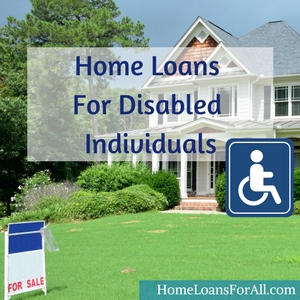 Fortunately, there a multitude of programs that help everyone become homeowners. We’ve compiled all you need to know about buying a home, and how to take advantage of the various programs available to acquire a home for disabled individuals.
Fortunately, there a multitude of programs that help everyone become homeowners. We’ve compiled all you need to know about buying a home, and how to take advantage of the various programs available to acquire a home for disabled individuals.
We will go over all the important aspects such as:
Government Programs
There are many government-sponsored programs that can help individuals to homeownership. This is from a wide range of programs from grants, loans, as well as advice and planning.
Non-Government Programs
There is also a wide range of non-governmental and nonprofit programs available to prospective home buyers. Many of these programs work with low-income individuals, but also provide priority support to the elderly and disabled.
Tips and Tricks
This article will also go over many tips and tricks that can help along the process. This includes good-to-know aspects that will help the process move along smoother, as well as additional resources for those looking for additional support.
We Can Help You Get Your Home Loan Approved
Fill Out The Form Below To Get Help Today!
By the end, you’ll have all you need to know to become a homeowner. Buying a home for disabled persons shouldn’t be impossible. With the right knowledge, it can be a very achievable goal.
Advantages To Homeownership
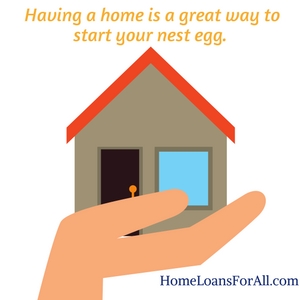 One of the prime reasons to buy a home is for that sense of accomplishment and independence. Owning a home is a very common goal, and there’s a great feeling of knowing you own the home and can do what you like with it. You can make it really comfortable for your needs and tastes. Not all property for rent can allow for very important changes. Only buying the house for the disabled can become an actual commodity.
One of the prime reasons to buy a home is for that sense of accomplishment and independence. Owning a home is a very common goal, and there’s a great feeling of knowing you own the home and can do what you like with it. You can make it really comfortable for your needs and tastes. Not all property for rent can allow for very important changes. Only buying the house for the disabled can become an actual commodity.
There are also financial reasons and the large amount of equity you have when you own a home. In the long term, a home is a great investment and saves money over renting in the long run. It’s great to be able to retire and not have to worry about your housing payment.
House prices have historically on average gone up a well. So, it’s very likely that in 10-20 years your home will be worth much more than when you first bought it. Having a home is a great way to start your nest egg.
Disadvantages To Homeownership
It’s also important to keep in mind the flip side and understand the responsibilities of homeownership. The most glaring one, especially for disabled individuals, is the upkeep.
Depending on the specific disability, common household chores like mowing the lawn or shoveling the snow can be difficult, and unlike an apartment unit, these responsibilities fall on the homeowner. It’s important to know how you’ll manage the upkeep of the home and keep it in good order.
There are also expenses that you need to account as well. The odd repair, replacing broken pieces, and the unavoidable property tax can be pretty annoying. Many of these expenses are unique to homeownership and are important to keep in mind.
For those looking to learn more, many of the programs listed below have ties to homeownership classes which help prospective homeowners learn more, and some may require a course be completed before benefits are awarded.
Know Your Rights
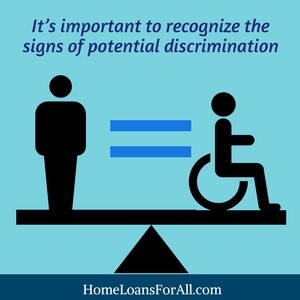 It’s unfortunate, but discrimination exists, and the housing market is no different. This is an issue both for renters as well as buyers. It’s important to recognize the signs of potential discrimination as it is illegal for anyone to discriminate based on a disability. Signs of discrimination include:
It’s unfortunate, but discrimination exists, and the housing market is no different. This is an issue both for renters as well as buyers. It’s important to recognize the signs of potential discrimination as it is illegal for anyone to discriminate based on a disability. Signs of discrimination include:
- The person makes rude and discriminatory comments.
- The seller behaves differently in front of other buyers.
- They disregard or ignore certain people, but seem to be responsive to others.
- A seller or lender requires different fees or a modified process for those with disabilities.
In situations where discrimination is taking place, there are protections and laws in place to stop it from happening. These laws create a fair playing field for all people, regardless of who they are. These protections cover a range of protected classes. However, in this case, we’ll look at how they apply to disabled individuals and potential discrimination they might face.
The Fair Housing Act
One such protection is the fair housing act. This was a law put in place to prevent discrimination in housing for any protected class, which includes those with disabilities.
This law affects all those in the selling process, including banks and lending institutions. It extends to both renting, as well as home buying.
That doesn’t prevent a lender for example from denying you but stipulates that they can not do so due to a disability. A bank can still deny you a loan for having poor credit, but can not if you’re in a wheelchair, for instance. This helps level the playing field and forces others to consider you on the same basis as everyone else.
Americans With Disabilities Act
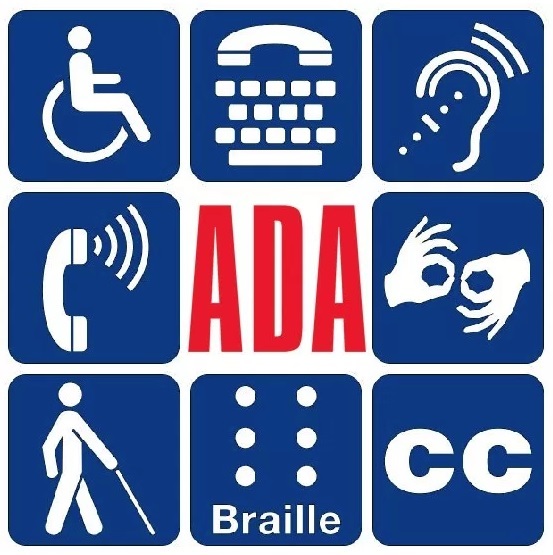 Another important law to keep in mind when buying a home while you’re disabled is the ADA or Americans With Disabilities Act. Put simply, this act requires that all disabled people are treated fairly in aspects of public life. This extends to home buying, as well as renting, and further prevents any sort of legal discrimination.
Another important law to keep in mind when buying a home while you’re disabled is the ADA or Americans With Disabilities Act. Put simply, this act requires that all disabled people are treated fairly in aspects of public life. This extends to home buying, as well as renting, and further prevents any sort of legal discrimination.
An important note, this act requires that the process is the same for all individuals. This means that a lender or seller cannot force a disabled individual to follow different processes, or pay extra fees. They must be on the same field as everyone else.
It also requires that a homeowner should be allowed to make reasonable accommodations to their property to fully enjoy it. This might come into play in a condo. For example, a disabled individual would be allowed to make modifications that others might be barred from making.
What If I’ve Been Discriminated Against?
If you feel you’ve been discriminated against the best move is to file a complaint against the offender through HUD. They have a form on their website that can be completed there or mail, or you can call them. They will ask questions regarding the incident and then perform an investigation and take appropriate action.
Home Needs
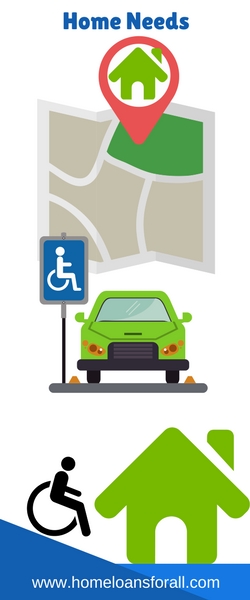 An important consideration to keep in mind is the actual home itself and whether it meets your accessibility needs. While some programs will help cover the costs of these additions, many times they will require out of pocket expenses. It might also be a good negotiation point when buying the home, some motivated buyers might agree to make accessibility additions to sell their home quicker.
An important consideration to keep in mind is the actual home itself and whether it meets your accessibility needs. While some programs will help cover the costs of these additions, many times they will require out of pocket expenses. It might also be a good negotiation point when buying the home, some motivated buyers might agree to make accessibility additions to sell their home quicker.
Parking
Parking is an important thing to consider, namely, what type is it and how far will you have to park. For suburban housing, this is likely not too big of an issue as many houses have driveways or garages, but cities can be different.
In larger cities, they utilize on-street parking, which can oftentimes be crowded and difficult to find. In a larger city, street cleaning can force you to park in different locations on certain days. This is unacceptable for a property for a disabled person.
Layout
The general layout of the home also plays a big role in accessibility. A well laid out home is easy to navigate and allows ample room for items like walkers or wheelchairs. This is largely going to be based on your individual needs, so keep this in mind when house shopping.
Location
Also, keep in mind whether the house is near to places you’ll need to visit frequently. If your disability requires frequent doctor visits, keep in mind how long you’ll have to travel back and forth each time. Doctor visits is one problem. How about groceries?
Construction
Lastly, keep in mind the construction of the home and the different features it might have. This includes things like stairwells, ramp, and the like. Depending on your needs, these might be important considerations. These large, structural changes can also be quite expensive. If the house you’re looking at doesn’t come equipped with them, it doesn’t worth it.
Getting Help
The best way to get started with any of the following programs is to find a lender or agent. They must have experience working with the various programs for disabled individuals. A lot of programs, qualifications, and eligibility can be confusing. It’s important to work with an expert who can make the process smoother.
They also might be aware of local programs that can help point out these opportunities. This might make the process of purchasing a home much easier.
HUD counselors
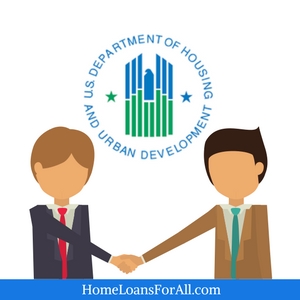 The Department of Housing and Urban Development (HUD) also provides resources that can assist all types of home buyers. The HUD has offices in all 50 states and has counselors that can help with any part of the home buying process.
The Department of Housing and Urban Development (HUD) also provides resources that can assist all types of home buyers. The HUD has offices in all 50 states and has counselors that can help with any part of the home buying process.
They can assist with the various types of government assistance available. They have broad experience in these programs and can help determine eligibility and assist in applications. They might also be able to point to additional sources of aid that can make securing the home even easier.
Financial Aid
Financial aid is one of the most important things to be on the lookout for when purchasing a home for disabled. Fortunately, there are some aid opportunities that come with a range of benefits such as lowered payments, down payment assistance, reduced interest rates, and more. Let’s take a look at some of the more popular programs a disabled home buyer might take advantage of.
Section 8
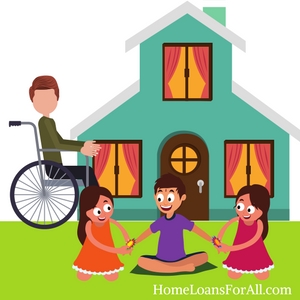
Section 8 is a government program that provides housing assistance for low income and disabled individuals and families. This program provides housing vouchers that can be used to acquire housing. These vouchers are not just for renting. Even better, this can count as income when applying for a mortgage, even with FHA loans.
Keep in mind though, a lender is going to want to be sure that any sources of income are going to last for the duration of the loan. If any public assistance is set to expire within three years of the mortgage application then it can not be counted as effective income.
State and Local Programs
There are also a variety of state and local programs throughout the country to take advantage of. These are put on by local governments and are generally restricted to the state, county, or city where the program is being offered from.
For example, the Chicago Housing Authority provides assistance for low-income individuals and families to find affordable housing. They offer vouchers and other assistance to make the process easier. They also a variety of utility allowances, which can further help reduce the cost of owning a home.
While this example is restricted to the city of Chicago, there are similar programs all throughout the country at various levels. It would be impossible to list them all here. So, make sure to do a bit of research to discover what’s available in your area. This is another good reason to work with an experienced lender, as they can likely help find any local programs and assistance in the application process.
Non-Profits
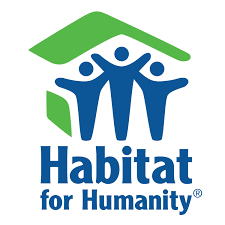 There are also a large number of non-profits, both national and local, that help low-income or disabled people find affordable housing.
There are also a large number of non-profits, both national and local, that help low-income or disabled people find affordable housing.
A well known example of this is the habitat for humanity. Habitat for Humanity helps to build housing all across the country for those in need of housing. This includes disaster support, but also for those with low income and disabilities.
This is just one example of a large, national nonprofit that can help provide affordable housing. There are many more throughout the country, and a large number of local nonprofits that can provide assistance. For example, many churches run programs that help individuals secure housing. Another good reason to work with experienced lenders who may know of these local options. Keep these in mind as they can provide a huge amount of support in everything from building a new home, or helping make an existing one more accessible.
Disabled Vet Program
 If you’re a veteran, you have additional options open to you. For those that were disabled in the line of duty, the government provides grants that can help them acquire housing affordably.
If you’re a veteran, you have additional options open to you. For those that were disabled in the line of duty, the government provides grants that can help them acquire housing affordably.
There are some requirements for what disabilities qualify, but for those that do this is a fantastic option. Even better, the grant can be used multiple times throughout an individual’s life.
The grant also has options for outfitting an existing home. If you already own a home then the grant can be used to improve accessibility to make it more livable for those with disabilities.
The grant does not need to be repaid. Isn’t it a fantastic option? Only veterans will qualify. If you are one, you should absolutely contact the local VA to take advantage of this program. VA surely wants to repay you.
Government Programs
In addition to those already mentioned, the government has a multiple programs to help disabled individuals find housing. Most of these programs are country-wide, so they can be used by individuals in most states and locations.
FHA Loans
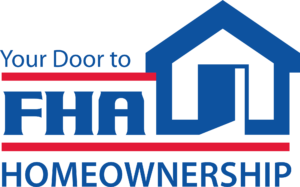 FHA loans are a great option for lots of low- income borrowers. FHA loans are government backed loans, that allow borrowers to secure a mortgage with as low as 3.5% down payment. They also have less strict requirements for income and credit scores. They want to help everyone from first-time homebuyers to disabled homebuyers.
FHA loans are a great option for lots of low- income borrowers. FHA loans are government backed loans, that allow borrowers to secure a mortgage with as low as 3.5% down payment. They also have less strict requirements for income and credit scores. They want to help everyone from first-time homebuyers to disabled homebuyers.
Many first time home buyers utilize these loans for that fact, but they aren’t exclusive to first time buyers.
FHA loan is even better because of the grants and vouchers offered by the government. These can be used as income when applying for this loan. This means for example, an individual can use their social security income to secure a FHA loan and purchase a home. Add to that the small down payment needed, and it becomes an attractive choice.
It’s important to keep in mind though, most lenders when looking at income want to be reasonably sure that the income will last long enough to pay for the loan. In most cases, they will want to make sure the assistance will last for at least three years.
This means that income from short term disability aid doesn’t last long, as it will likely drop off before the three year mark. If you’re looking to use assistance as income on your mortgage application make sure that it will last at least until the three year mark.
There are some requirements for the type of housing, for instance an FHA loan does require an inspection to be completed. There is also some additional paperwork that many sellers amount to extra time. Some sellers are apprehensive about dealing with FHA loan users.
HUD Programs
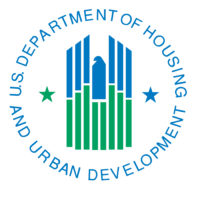 The Department of Housing and Urban Development is a great resource for disabled individuals looking to purchase a home. They offer a variety of services and programs to help disabled people find housing.
The Department of Housing and Urban Development is a great resource for disabled individuals looking to purchase a home. They offer a variety of services and programs to help disabled people find housing.
Their website is a great resource that goes over a lot of important information. It also includes lots of good information on the various programs available to disabled individuals, as well as what to do in the case of discrimination.
HUD also offers vouchers through local public housing associations. These help subsidize the cost of mortgage payments, and can help low income and disabled individuals acquire a home. In order to see what options are available near you, visit your local public housing association, and they’ll be happy to help you.
Social Security Disability Programs
 Social security is one of the largest social programs the government offers, and has multiple options for disabled individuals. Social security benefits come in two different types.
Social security is one of the largest social programs the government offers, and has multiple options for disabled individuals. Social security benefits come in two different types.
Supplemental Social Security (SSI): Supplemental Social Security is a needs based program. There is no requirement on age or hours worked, but does have restrictions on income and assets as it is meant for lower income individuals.
Social Security Disability Insurance(SSDI): Social Security disability insurance is not income based, but is available to those who have worked a certain amount of hours and contributed to the social fund through taxes. These benefits can also extend to certain family members.
In either case, applications require the submission of medical documents in order for a decision to be made. It’s important to apply as soon as possible if you’re disabled as SSDI is not paid for the first five months.
Applications are accepted online or via the phone. The social security administration also offers a started kit on their website. This kit walks through the entire process, and points out all the required documents you will need to submit to qualify. It also covers the exact benefits available, and is a great place to start for those considering applying.
Once approved, and after waiting any applicable time, you’ll begin receiving Social security disability benefits from the social security administration. The amount varies from person to person, with the averages ranging from $700 to $1700 per month.
This amount can also be influenced by other government payouts for disabilities. If you’re receiving other forms of disability then you’re payments from social security may be reduced.
Once you’re getting the fees, they can count as income when applying for a mortgage. Keep in mind, though, this will only be the case if the benefits last more than three years.
The big issues with social security is the strict requirements. The income or working requirements for either one can disqualify many. There’s also the five month waiting period for SSDI that can a serious problem for those looking to use the benefits quickly.
Low Income Government Programs
In addition to what’s mentioned above, there are a number of low income government programs. These programs can also be utilized by disabled individuals who are within the acceptable income range.
Section 8 Homeownership Voucher Program
Most people are aware that section 8 housing is a low-cost rental, but not many know that the vouchers provided in the section 8 program can be used to purchase a home as well. The section 8 homeownership voucher program was set up to allow section 8 recipients to use their stipend to purchase a home.
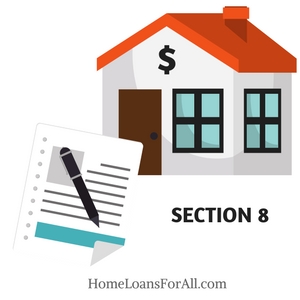 The program itself is only open to first time home buyers and has some strict income requirements. The process can be a different in each state, but in general the first step is to talk to the local public housing authority. In most cases, those with disabilities are given priority, making it quicker for these individuals to find housing.
The program itself is only open to first time home buyers and has some strict income requirements. The process can be a different in each state, but in general the first step is to talk to the local public housing authority. In most cases, those with disabilities are given priority, making it quicker for these individuals to find housing.
Once the process begins, you’ll have to attend some sort of homeownership counseling program. This is to ensure that the buyers are educated on homeownership and understand their responsibilities. In the end, most mortgages give out through this program are government-backed FHA loans.
This makes sense as these loans are made for lower-income individuals, and provide the lender extra security when working with more risky borrowers.
One of the prime disadvantages of section 8 is the difficulty of approval. Each year, only a limited amount of money is allocated towards this program. This means that only a limited number of applicants will be approved; not all who qualify will receive the benefits. This uncertainty can make many applicants uncomfortable. It also has some strict income requirements, and your benefits can be cut off if your income rises above this limit.
USDA Single Family Housing Direct Home Loans
 Also referred to as the section 502 Direct Loan Program, this provides assistance to low-income borrowers in certain rural areas around the country. The program provides payment assistance, which can help secure a loan and lower the payment amounts.
Also referred to as the section 502 Direct Loan Program, this provides assistance to low-income borrowers in certain rural areas around the country. The program provides payment assistance, which can help secure a loan and lower the payment amounts.
The main requirement for this type of loan is the rural location. The USDA has a map of which locations qualify. Outside of that, there are also maximum income requirements, this loan is for low-income individuals, as well as property requirements. It is also necessary for the home to be the buyer’s primary residence.
The primary benefit of this type of loan is a 100% financing with no money down, and the ability to secure an extended rate depending on an individual’s income. This is great for low-income borrowers as it allows them to forgo one of the largest obstacles for home buyers, the down payment.
It also allows the borrower to extend their mortgage to a total of 38 years, a bit longer than the standard 30. This extra length lowers the payments and can help make the mortgage payment much easier to manage.
The major downside is the rural requirement which will prevent those living in more populous areas and large cities from qualifying. It’s also important to note that this is a loan, and needs to be repaid. Unlike other options that may be granted, this is not free money and still does have some income and credit requirements.
Also, the infrastructure of the rural areas might not be as perfect as in bigger cities. This might be a very significant disadvantage of these home loans for disabled persons.
Additional Programs Available
USDA Guaranteed Home Loan Program
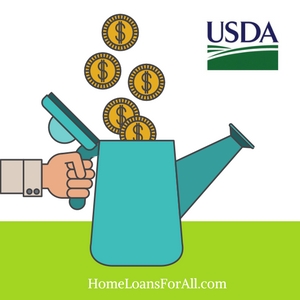
A common mistake is to assume that the USDA only offers a single loan option, but that is not the case. Many confuse the Guaranteed Home Loan Program with the 502 direct loan program mentioned above. While the loans are different, they do both have the rural location requirement; locations can be checked on USDA website, and are both offered by the USDA.
The big difference between the two is that the Guaranteed Loan is available for higher-income individuals, and also has stricter requirements in terms of credit and income minimums. It’s also important to note that the guaranteed loan program loans are actually served by qualified 3rd parties.
That means that they will all have their own specifics for requirements, as well as their own loan terms such as interest rates, similar to FHA.
The main benefit of this loan is 0 down financing, and no requirement to carry private mortgage insurance. You can also roll closing and renovation costs into the loan itself. This cuts the costs greatly for borrowers and provides an easy way for individuals to become homeowners.
The main drawback is similar to the direct loan in that it can only be used to purchase homes in certain rural locations. This locks out a lot of potential users who are in non-covered areas and large cities. It also has stricter credit score requirements, generally 640+, as well as having a good debt to income ratio. This locks out a lot of lower-income individuals who might either have poor credit or simply not enough income to qualify.
Veterans Affairs Specially Adapted Housing Grants
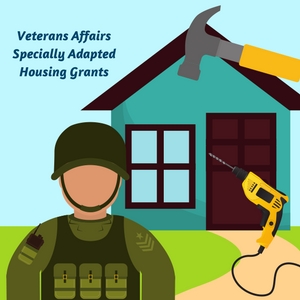 The Specially Adapted Housing Grants are grants provided by the VA for service members that were injured and disabled in the line of duty.
The Specially Adapted Housing Grants are grants provided by the VA for service members that were injured and disabled in the line of duty.
To qualify, you can apply online, in person, or through the mail. The VA benefits site provides the exact details, but you’ll need to provide proof of a qualifying disability as well as release papers from service.
In most cases, your release will need to be something other than a dishonorable discharge. It’s also important to note that not all disabilities qualify, the VA keeps the list of what qualifies for these types of loans.
The grant itself varies year to year, but for 2020 a qualifying service member could qualify for up to three grants totaling $90,364. This money can be used to purchase a new home or make changes to an existing property. In both cases, the home must be a permanent, long term dwelling.
The main disadvantage of this program that will bar many from it is the requirement to be a disabled service member. What’s more, that disability must have come from your service, so this will further limit the number of individuals who qualify.
Lastly, there is a limit on how many such grants can be given per year, so even if a veteran qualifies it’s possible that there will not be any grants left to give for the year. This makes it a bit uncertain on whether an individual will actually receive the grant.
Non-Profit Homeownership Programs for the disabled
As noted above, there is a large number of non-profit programs to help disabled individuals purchase homes. These programs vary widely in reach, some are nationwide while others only touch on a specific city. They also differ in the kinds of support they offer.
Habitat For Humanity
One of the most well-known housing nonprofits that is nationwide is Habitat for Humanity. They’re most well known for physically building houses for the needy. Also, they provide help with down payments and securing mortgages. They’re very familiar with the needs of disabled people and will work to put them in a house that will work for them in terms of construction and features.
The application process is handled locally at one of the many Habitat for Humanity locations all over the country. The applicant will be required to demonstrate a need for safe housing, and this will then be reviewed by Habitat staff. The applicant will also have to be willing to invest “sweat equity” and partner with Habitat. This might include building their own home, building others in the community, or performing other volunteer duties.
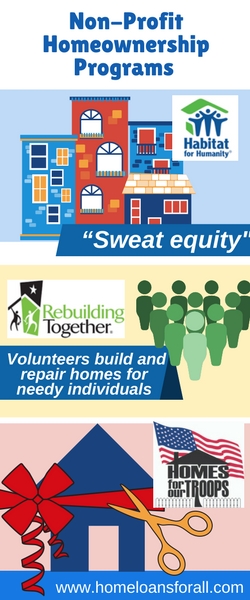 The biggest disadvantage of Habitat for Humanity is the time it can take from application to a livable home. In many cases, it can take well over a year from start to finish. This means many people going through the process will have to find alternate housing in the meantime, which can be difficult or expensive. They also have limited resources, and you’ll have to get lucky to get approved. Unfortunately, they can’t build a home for every single person in need.
The biggest disadvantage of Habitat for Humanity is the time it can take from application to a livable home. In many cases, it can take well over a year from start to finish. This means many people going through the process will have to find alternate housing in the meantime, which can be difficult or expensive. They also have limited resources, and you’ll have to get lucky to get approved. Unfortunately, they can’t build a home for every single person in need.
Rebuild Together AmeriCorps
The rebuild together program is another non-profit that helps individuals. They perform actions such as building and repair homes for needy individuals and help to revitalize communities. They do this by partnering with other charities and businesses, as well as utilizing volunteers.
To apply, you’ll need to contact your local affiliate. These are located all over the country, and they have a list of them, and their contact info, on the Rebuild Together Website. Once in contact with the local affiliate, they have an application process where you will need to demonstrate a need, whether help with housing or repairs to your current home. The good news, they give priority to elderly or disabled applicants.
The main drawback is the timeline as it can take months to be approved. There is also a limit to how much work they are able to do, and unfortunately, they can not provide assistance to every needy individual.
Homes For Our Troops
The Homes For Our Troops program is set up to provide no-cost housing to severely injured veterans post 9/11. They do this by building new, specially adapted homes to help these veterans rebuild their lives.
Applications are started by filling out the form on their website. After which the applicant will need to provide a Specially Adapted Letter of Eligibility from the VA, as well as pass a criminal background check. The applicant will then need to be able to demonstrate that they can perform basic upkeep, and maintain the house after it’s built.
If accepted, the veteran is awarded a home at no cost to them. They also are not required to pay a mortgage, and within 10 years will have complete ownership of the home. Homes For Our Troops also provide support afterward to make sure the veteran is able to maintain and keep their new home.
Once again, the drawback here is the timeline. Their website states an average project can take anywhere from 18-24 months. That’s a long time for those in need of housing now. They’re also quite selective in who actually qualifies, so the pool of disabled individuals who will be accepted into the program is small.
Additional Resources
Outside of all the resources listed here are a ton more out there that can help individuals find home loans for disabled persons. These organizations provide a wide variety of services and can help with many of the confusing aspects of the mortgage process. In many cases, working with these organizations is free on the part of the individual, and can speed up or simplify the entire process.
American Association for People with Disabilities
 The American Association for People with Disabilities, or AAPD, is an organization set up to help promote the political and economic power of people with disabilities. They can provide additional assistance in any aspect of the process, as well as helping protect from discrimination.
The American Association for People with Disabilities, or AAPD, is an organization set up to help promote the political and economic power of people with disabilities. They can provide additional assistance in any aspect of the process, as well as helping protect from discrimination.
National Disability Institute
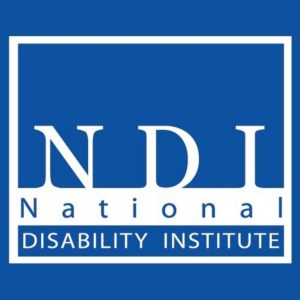 The National Disability Institute is similar to the AAPD in that they provide support to help elevate disable individuals to good financial standing. They provide a wide range of services, from helping with tax filing to assistance with finding employment. They are an excellent resource for home loans for disabled individuals and disabled persons that need help in really any aspect of their financial life.
The National Disability Institute is similar to the AAPD in that they provide support to help elevate disable individuals to good financial standing. They provide a wide range of services, from helping with tax filing to assistance with finding employment. They are an excellent resource for home loans for disabled individuals and disabled persons that need help in really any aspect of their financial life.
National Organization on Disability
 The National Organization on Disability is another resource for disabled individuals and focuses on helping them find employment. They work with businesses to help evaluate their policies and assist disabled individuals in finding employment.
The National Organization on Disability is another resource for disabled individuals and focuses on helping them find employment. They work with businesses to help evaluate their policies and assist disabled individuals in finding employment.
Home Loans For Disabled Individuals
While the process of buying a home for disabled individuals can be daunting it need not be impossible. With all the resources and programs available to them, find help is all about knowing where to look. With the help of these programs, securing a home or a mortgage can be a much easier process.
FAQ

Ask away!
What is SSDI?
SSDI stands for Social Security Disability Insurance, and is monthly pay to people who are unable to work due to a disability or illness that is expected to last longer than a year. This benefit is based on worked done at a job covered by social security and tax monies paid into the fund.
I’m a Disabled Veteran, What’s the Best Way To Buy a Home?
The VA offers multiple grants and programs to help disabled veterans buy a home. The best first step is to contact your local VA, and discuss what options are available to you, and what sort of benefits your disability qualifies for.
It also depends on whether your disability was caused by your service.
In addition to the VA programs, there are many nonprofits that offer housing to disabled veterans.
Can a Bank Not Approve Me For a Loan Because I’m Disabled?
No, there are multiple laws in place that protect disabled individuals from discrimination based solely on the fact that they are disabled. What that means, is a bank, agent, seller, or anyone in the process can not choose to not deal with an individual solely on the basis of their disability. That said, these individuals can still be denied based on normal items such as poor credit and doing so is within the right of the lender.
Can you buy a house while on SSI?
Yes, there is nothing stopping and individual on SSI from using their benefits to buy a home.
What is the best loan for people on SSI?
This largely depends on the unique situation of the individual, there a lot of good home loans for disabled individuals. For example, a the disabled vet has many good loan options provided by the VA. Others might looks to options like FHA backed loans. The best move is to talk to an experienced lender or the multitude of disability organizations that can walk you through your options.
Can I Use Section 8 Benefits To Buy a Home?
In certain cases yes, section 8 has a special home voucher program. If you meet the requirements, you’ll be able to use your section 8 benefits to purchase a home.
What are the downsides of using nonprofit home builders and assistance like Habitat for Humanity?
The main downside for many nonprofits is the time it takes to get approved. In many cases these programs can take over a year to place an individual in a home. This is due to the limited resources these organizations have, and the approval process they use to make sure they allocate them where they can do the most good.
My Adult Child Is Disabled, Is there any programs specifically for me?
Yes, in addition to what’s listed certain lenders will allow the parent to be the technical owner of the home. This is generally the case when the child cannot work due to their disability and is unable to acquire enough income to apply for a mortgage on their own.
Additional Resources
by Mike Plambeck
 Owning your own home is truly awesome and it’s very beneficial too. I say this for one good reason and that reason is the tax benefits. Paying your taxes may seem like a real pain but for anyone who owns a home, paying your taxes is less painful because it can save you lots of money indeed! Whether you have paid the house in full or you have a mortgage on it there are a multitude of ways that you can reap the deductions and tax benefits for yourself.
Owning your own home is truly awesome and it’s very beneficial too. I say this for one good reason and that reason is the tax benefits. Paying your taxes may seem like a real pain but for anyone who owns a home, paying your taxes is less painful because it can save you lots of money indeed! Whether you have paid the house in full or you have a mortgage on it there are a multitude of ways that you can reap the deductions and tax benefits for yourself.
Homeowners that have a mortgage or loan for under $1 Million are able to save a large amount of money because the interest payments on the mortgage or loan are actually tax deductible. This can save people a lot of money because mortgage payments are very high in interest and the interest payments of a long term loan can actually top the principal payments for the first few years. Get your interest payments back now.
Get a free mortgage rate quote here.
The next way that you can save money on your home is by using discount points. Discount points are something that a homeowner purchases when they a buy a home and this allows them to receive interest rates on their mortgage substantially below current rates. This is a huge money saver because these discount points are tax deductible too.
Furthermore, another thing that is tax deductible to a certain degree is the real estate tax that you pay on your home. Call your accountant and find out just how much you can save by getting back your real estate taxes.
Compare rates from multiple lenders.
Moreover, home improvements are tax deductible as well. This is especially the case for people who have to renovate their home to accommodate a disabled person. This is also the case when renovating a home to make it more eco-friendly, sustainable, and energy saving.
Next, for any entrepreneurs, home business offices, or people who simply work at home, it is also possible to deduct the expenses of running an office from your house from your taxes; the list goes on and on!
Finally, always keep in mind what your expenses and costs will be, try to subtract the money you can save from tax benefits and you will be able to build yourself a real and formal budget regarding house and mortgage payments.
Read up on how you can lower your homeowners insurance here!
by Leslie Rowberry
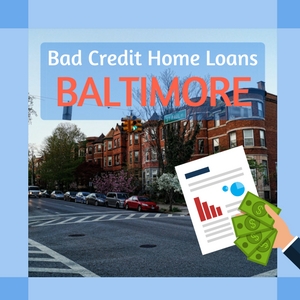 If you have poor credit, you may feel like your dreams of homeownership are only possible in a very distant reality. You may be tempted to feel discouraged by the lack of available options, but you should know that there are plenty of Bad Credit Home Loans in Baltimore that you could qualify for, even with an extremely low credit score. The key to knowing which programs will meet your needs is to understand and identify the essential factors that mortgage lenders want prospective applicants to have.
If you have poor credit, you may feel like your dreams of homeownership are only possible in a very distant reality. You may be tempted to feel discouraged by the lack of available options, but you should know that there are plenty of Bad Credit Home Loans in Baltimore that you could qualify for, even with an extremely low credit score. The key to knowing which programs will meet your needs is to understand and identify the essential factors that mortgage lenders want prospective applicants to have.
The first and most important consideration for a mortgage is your credit score. This is determined in large part by your payment history and credit utilization. Individuals who have a difficult time making their payments each month or who have excessive debts will have a lower credit score.
We can help you find a home loan no matter what state your credit is in. Click to Get Pre-Qualified Now
On the other hand, consumers who pay their bills on time each month and use very little of their available credit lines will have a higher credit score that qualifies them for lower rates and more favorable terms.
The other essential consideration that lenders take a look at is your debt-to-income ratio. This number compares the amount of debt you accumulated such as student loans, auto loans, and any preexisting mortgages to your current gross income. Most lenders like to see your debt take up no more than forty percent of your gross income.
While these are definitely important deciding factors for lenders, you can still find plenty of bad credit home loans in Baltimore if you know where to look.
I have bad credit. What do I do now?
Once your credit is ruined, it can take a long time to rebuild it to a point where most lenders would be pleased. You may need to start looking into government programs that are designed to help make homeownership a reality, even for individuals and families with bad credit.
Government Programs
Baltimore Homeownership Incentive Program (B-HiP)

Funds are available to help individuals with bad credit to purchase vacant homes that have been remodeled across the city. They may receive up to $10,000 in down payment assistance as well as help with closing costs. All eligible properties must be vacant for at least one year before they will qualify for the Vacants to Value Booster Program offered under the B-HiP umbrella.
They also have the Community Development Block Grant program that offers down payment and closing cost assistance that will allow you to live close to your place of employment. The city and the employers are encouraged to offer higher levels of assistance to prospective homeowners who want to move closer. However, not all employers are eligible.
Maryland Mortgage Program
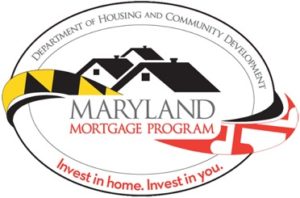
The Maryland Mortgage Program provides additional incentives for homeowners who want to purchase a home in the Baltimore area. They run several programs including the Down Payment and Settlement Expense Loan Program (DSLEP), House Keys 4 Employees, and Smart Keys 4 Employees.
You must meet certain income requirements based on the number of occupants in your home but you do not need to be a first-time buyer if you plan to purchase a home in the Baltimore area.
Read our article on Bad Credit Home Loans in Maryland here!
Federal Programs
The federal government has an additional list of programs that can help individuals with bad credit to obtain their goal of homeownership. These are great for individuals who need bad credit home loans in Baltimore.

FHA Loans
The Federal Housing Administration is willing to secure a portion of the financing for eligible homebuyers. Most people prefer this program because it does have a very low down payment of just 3.5 percent (higher if you have credit scores lower than 580). Lenders do not set a minimum credit score on these loans which makes them ideal for bad credit home loans in Baltimore.
VA Loans
Eligible service members and veterans may want to investigate whether they can qualify for a VA loan on their next home purchase. This advantageous program can help you to save thousands of dollars with its favorable terms and conditions. You will not need a down payment and private mortgage insurance is waived on these programs. Much like the FHA loan program, there are no minimum credit score requirements on VA loans.
USDA Loans
Rural homes may qualify for a loan through the United States Department of Agriculture. These loans are typically for individuals with higher credit scores, but they can be underwritten manually by the lender to make them into bad credit home loans in Baltimore. The trick will be finding an eligible property in this mostly urban area.
Rent to Own Options in Baltimore
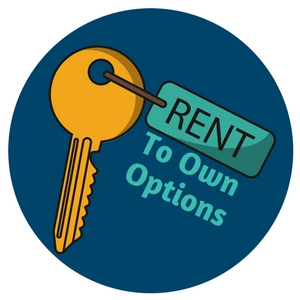
Alternatively, you may decide that you would rather consider renting a home right now with the option of purchasing it in the years ahead. This is a great alternative for homeowners who are still struggling to find lenders willing to work with their low credit scores. You can find a rent-to-own property and sign a contract with a potential options fee, similar to a down payment.
Throughout the course of your lease, a portion of your monthly payment is applied to the principal of the home. You can start living in the property now even while you’re saving to purchase a home of your own. When the lease is up, you will be given the option and opportunity to purchase the property outright. You will need to find a lender at this point to finalize financing for the remaining balance of the home.
Cosigner on a Home Loan
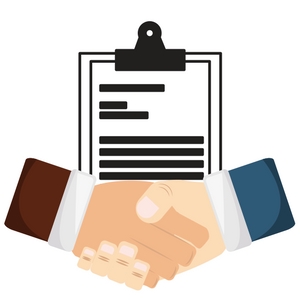
If your credit score simply isn’t high enough to qualify you for a home loan, you can ask a trusted friend or family member to cosign on the loan with you. This allows lenders to consider their credit score in addition to your own before setting the terms of a potential mortgage. Be aware that your cosigner will now be responsible for the payments if you fail to make them.
By cosigning on your loan, they are directly tying their own credit score to your property.
This is a major commitment for a friend or family member to make so be sure to take time to evaluate whether you are confident you can afford the home first. However, if you are sure you can do it, their higher credit score could allow you to qualify for better interest rates and terms on the mortgage.
First Time Home Buyers in Baltimore with Bad Credit
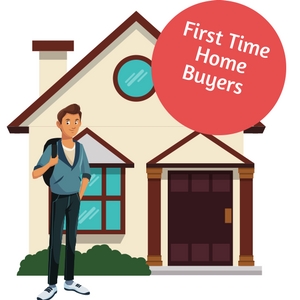
Many first-time buyers prefer to use FHA loans to make their purchase when they need bad credit home loans in Baltimore. The benefits of this program make homeownership a more realistic possibility for those who haven’t had time to save up thousands of dollars for the necessary down payment.
A first-time home buyer with a credit score of 580 or higher will need a 3.5 percent down payment. If you have a lower credit score, they may consider other compensating factors such as a higher down payment. Credit scores lower than 580 will require a ten percent down payment.
Bad Credit Home Loans in Baltimore After Bankruptcy
When you cannot make your mortgage payment, the house may move into foreclosure or you could file for bankruptcy. Both of these major life events can have a serious impact on your credit score and prevent you from qualifying for future financing on a new home. With work on your credit score, you can qualify for a mortgage again but there are certain waiting periods before you can purchase another Baltimore home.
Conventional financing will require you to postpone your next purchase for seven years or more. Fortunately, many of the federal programs offer more lenient waiting periods. FHA loans require a three-year waiting period while VA loans require only a two-year waiting period.
During your wait, you should be taking steps to ensure that you are rebuilding your credit. This can allow you to qualify for better interest rates and terms on your next mortgage.
Assistance Available in Baltimore
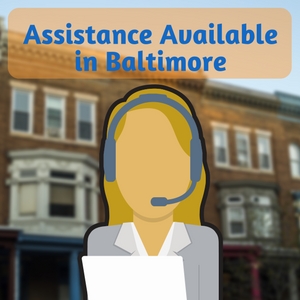
If you’re interested in purchasing a new home, you should take advantage of all the assistance available to you. A HUD-approved housing counseling agency and the Department of Housing and Community Development are available to answer questions and guide you on how to take the first steps toward homeownership.
Consider contacting these agencies if you have questions about what a new mortgage might look like for you in the Baltimore area.
Homestead Tax Credit
The homestead tax credit can also help to make a potential property more affordable for you in the future. This credit limits the amount that properties can be taxed during increases each year. Each county will set their own homestead tax credit percentages so be sure to find out what you can expect.
How to Improve Your Credit Score
Boosting your credit score can be an extremely slow and painstaking process. It takes years to rebuild the damage that may have been done to your credit over time. The best thing you can do now is to focus on demonstrating that you are a trustworthy borrower.
You can do this in two primary ways. The first is to make sure you pay each bill on time every month. This clearly illustrates that you have a grip on your financial responsibilities and has a huge impact on your credit score when done consistently.
The second major step is to pay down some of your debt to lower your overall credit utilization. This effectively improves your credit score and lowers your debt-to-income ratio, both of which make you more appealing to lenders.
Make sure that you are consistent in the effort you put forth to improve your credit score. While it will take time, you can keep tabs on it with free sites like Credit Karma.
Conclusion
Homeownership can easily be a reality for everyone, no matter what your financial history may look like. Be sure to take the first steps toward improving your credit score and searching for the bad credit home loans in Baltimore that suit your needs. With these key steps in mind, you can find the home of your dream sooner than you thought.






 Fortunately, there a multitude of programs that help everyone become homeowners. We’ve compiled all you need to know about buying a home, and how to take advantage of the various programs available to acquire a home for disabled individuals.
Fortunately, there a multitude of programs that help everyone become homeowners. We’ve compiled all you need to know about buying a home, and how to take advantage of the various programs available to acquire a home for disabled individuals. One of the prime reasons to buy a home is for that sense of accomplishment and independence. Owning a home is a very common goal, and there’s a great feeling of knowing you own the home and can do what you like with it. You can make it really comfortable for your needs and tastes. Not all property for rent can allow for very important changes. Only buying the house for the disabled can become an actual commodity.
One of the prime reasons to buy a home is for that sense of accomplishment and independence. Owning a home is a very common goal, and there’s a great feeling of knowing you own the home and can do what you like with it. You can make it really comfortable for your needs and tastes. Not all property for rent can allow for very important changes. Only buying the house for the disabled can become an actual commodity. It’s unfortunate, but discrimination exists, and the housing market is no different. This is an issue both for renters as well as buyers. It’s important to recognize the signs of potential discrimination as it is illegal for anyone to discriminate based on a disability. Signs of discrimination include:
It’s unfortunate, but discrimination exists, and the housing market is no different. This is an issue both for renters as well as buyers. It’s important to recognize the signs of potential discrimination as it is illegal for anyone to discriminate based on a disability. Signs of discrimination include: Another important law to keep in mind when buying a home while you’re disabled is the ADA or
Another important law to keep in mind when buying a home while you’re disabled is the ADA or An important consideration to keep in mind is the actual home itself and whether it meets your accessibility needs. While some programs will help cover the costs of these additions, many times they will require out of pocket expenses. It might also be a good negotiation point when buying the home, some motivated buyers might agree to make accessibility additions to sell their home quicker.
An important consideration to keep in mind is the actual home itself and whether it meets your accessibility needs. While some programs will help cover the costs of these additions, many times they will require out of pocket expenses. It might also be a good negotiation point when buying the home, some motivated buyers might agree to make accessibility additions to sell their home quicker. The Department of Housing and Urban Development
The Department of Housing and Urban Development
 There are also a large number of non-profits, both national and local, that help low-income or disabled people find affordable housing.
There are also a large number of non-profits, both national and local, that help low-income or disabled people find affordable housing. If you’re a veteran, you have additional options open to you. For those that were disabled in the line of duty, the government provides grants that can help them acquire housing affordably.
If you’re a veteran, you have additional options open to you. For those that were disabled in the line of duty, the government provides grants that can help them acquire housing affordably. FHA loans are a great option for lots of low- income borrowers. FHA loans are government backed loans, that allow borrowers to secure a mortgage with as low as 3.5% down payment. They also have less strict requirements for income and credit scores. They want to help everyone from first-time homebuyers to disabled homebuyers.
FHA loans are a great option for lots of low- income borrowers. FHA loans are government backed loans, that allow borrowers to secure a mortgage with as low as 3.5% down payment. They also have less strict requirements for income and credit scores. They want to help everyone from first-time homebuyers to disabled homebuyers. The Department of Housing and Urban Development is a great resource for disabled individuals looking to purchase a home. They offer a variety of services and programs to help disabled people find housing.
The Department of Housing and Urban Development is a great resource for disabled individuals looking to purchase a home. They offer a variety of services and programs to help disabled people find housing. Social security is one of the largest social programs the government offers, and has multiple options for disabled individuals. Social security benefits come in two different types.
Social security is one of the largest social programs the government offers, and has multiple options for disabled individuals. Social security benefits come in two different types. The program itself is only open to first time home buyers and has some strict income requirements. The process can be a different in each state, but in general the first step is to talk to the local public housing authority. In most cases, those with disabilities are given priority, making it quicker for these individuals to find housing.
The program itself is only open to first time home buyers and has some strict income requirements. The process can be a different in each state, but in general the first step is to talk to the local public housing authority. In most cases, those with disabilities are given priority, making it quicker for these individuals to find housing. Also referred to as the section 502 Direct Loan Program, this provides assistance to low-income borrowers in certain rural areas around the country. The program provides payment assistance, which can help secure a loan and lower the payment amounts.
Also referred to as the section 502 Direct Loan Program, this provides assistance to low-income borrowers in certain rural areas around the country. The program provides payment assistance, which can help secure a loan and lower the payment amounts.
 The Specially Adapted Housing Grants are grants provided by the VA for service members that were injured and disabled in the line of duty.
The Specially Adapted Housing Grants are grants provided by the VA for service members that were injured and disabled in the line of duty. The biggest disadvantage of Habitat for Humanity is the time it can take from application to a livable home. In many cases, it can take well over a year from start to finish. This means many people going through the process will have to find alternate housing in the meantime, which can be difficult or expensive. They also have limited resources, and you’ll have to get lucky to get approved. Unfortunately, they can’t build a home for every single person in need.
The biggest disadvantage of Habitat for Humanity is the time it can take from application to a livable home. In many cases, it can take well over a year from start to finish. This means many people going through the process will have to find alternate housing in the meantime, which can be difficult or expensive. They also have limited resources, and you’ll have to get lucky to get approved. Unfortunately, they can’t build a home for every single person in need. The American Association for People with Disabilities, or AAPD, is an organization set up to help promote the political and economic power of people with disabilities. They can provide additional assistance in any aspect of the process, as well as helping protect from discrimination.
The American Association for People with Disabilities, or AAPD, is an organization set up to help promote the political and economic power of people with disabilities. They can provide additional assistance in any aspect of the process, as well as helping protect from discrimination. The National Disability Institute is similar to the AAPD in that they provide support to help elevate disable individuals to good financial standing. They provide a wide range of services, from helping with tax filing to assistance with finding employment. They are an excellent resource for home loans for disabled individuals and disabled persons that need help in really any aspect of their financial life.
The National Disability Institute is similar to the AAPD in that they provide support to help elevate disable individuals to good financial standing. They provide a wide range of services, from helping with tax filing to assistance with finding employment. They are an excellent resource for home loans for disabled individuals and disabled persons that need help in really any aspect of their financial life. The National Organization on Disability is another resource for disabled individuals and focuses on helping them find employment. They work with businesses to help evaluate their policies and assist disabled individuals in finding employment.
The National Organization on Disability is another resource for disabled individuals and focuses on helping them find employment. They work with businesses to help evaluate their policies and assist disabled individuals in finding employment.

 If you have poor credit, you may feel like your dreams of
If you have poor credit, you may feel like your dreams of 















